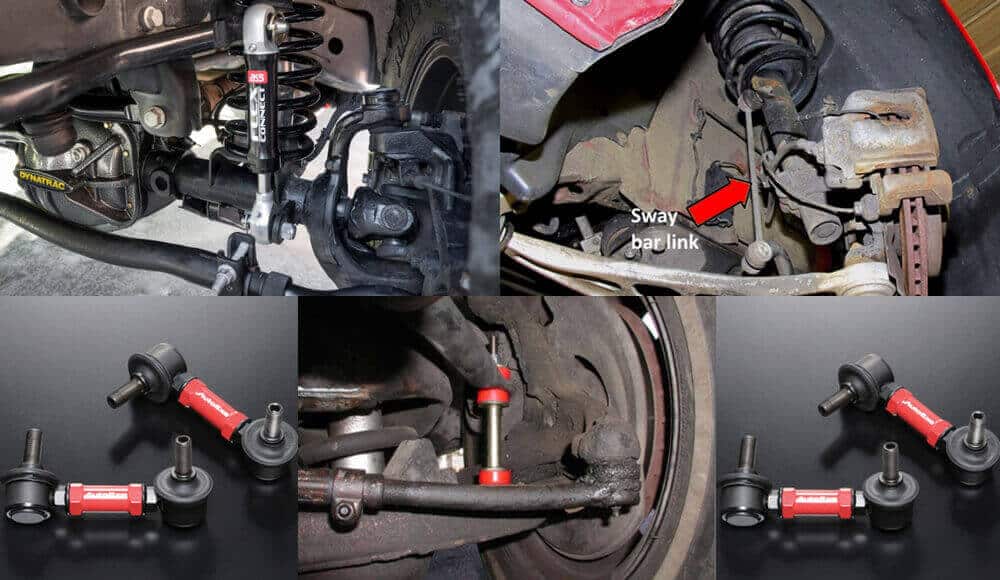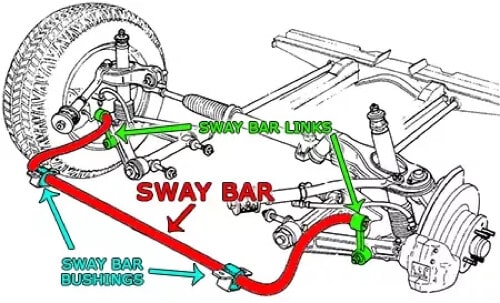October 4, 2020

Vehicles depend on the sway bar link to help lessen the car’s body roll when making a sharp or fast turn. It is part of the many components of a car that ensures the safety of the occupants when it encounters road irregularities. To fully understand how it works, let us get to know the other different elements connected to them.
The sway bar, also known as the anti-sway bar or anti-roll bar or stabilizer bar, is a durable tubular steel piece that connects the opposing sides of both the front or rear suspension. It minimizes the body leaning of the vehicle during cornering.

The sway bar links are the connectors of the sway bar’s outer ends to the suspension, which holds the controlling arms of the wheel. These sway bar links are mostly four to six inches long, but it can vary depending on the make of the car. They can be found attached at 90° to the sway bar. On most cars, these links have a couple of small ball joints found at each end.
The body roll refers to the reaction of the car whenever it takes a turn at the corner of the road. When the vehicle makes a sharp turn, the rest of the weight of the entire body will be leaning or thrown to another side, causing the car to body roll.
If the sway bar was never invented, expect road mishaps as the handling of cars would be so much harder and rougher. Fortunately, back on April 22, 1919, a Canadian inventor by the name of Stephen Coleman of Fredericton, New Brunswick, was given the first stabilizer bar patent. Over the years, as the car’s make and system improved, the sway bar or anti-roll bar also improved. It became an integral part of car making, and during the 1950s, automobile manufacturers started fitting the cars with it.
Why Do Cars Need the Sway Bar and its Links?
Holding Both Wheels Together on the Same Level
Both the right and left wheels needed to be on the same level when turning to prevent the car from tilting to one side. Due to the different ways a car can be made, there are various sway bar designs out there, but the basic mechanism is the same. The sway bar or anti-roll bar holds them together to a similar height, whether it rises or lowers. It helps the wheels to adapt to whatever road irregularities they encounter when driving. For instance, after a sharp turn, the downward pressure will go back to normal, and the wheels will return to its regular height, and the sway bar helps them go through all of that action.
Helps The Vehicle’s Body Remain Flat
When you are driving a car or just one of the passengers, you can feel the car leaning to one side, whether to avoid an obstruction on the road or during cornering. To make sure that the body of the car remains flat on where it is supposed to be, the car will depend highly on the sway bar to make that happen. It counteracts the vehicle’s body roll, especially those with a higher center of gravity, such as trucks and vans. It serves as a spring that works to minimize movement of the suspension and sway of the vehicle.
Making Easy and Smooth Turns
A sway bar does nothing at all when driving on a straight, paved, and unobstructed road until the vehicle decided to make a turn. When it does, the vehicle will automatically start to lean on the outside of a turn, and it’s the sway bar job to apply force to the suspension on both sides. One goes up, and the other goes downward. It resists the leaning of the car and maintains a similar height distribution. The vehicle can make smooth and easy turns on the road.
Ability to Hug or Create Hugging Effect
The sway or stabilizer bar creates a “hugging effect.” When the sway bar forces the vehicle towards the inside wheels, the entire body frame will be thrown closer to the wheels when the vehicle needed to turn.
To completely understand the hugging effect, let’s go to the other side of the fence. Those driving with off-road vehicles such as Jeeps or Pick-ups would not want a sway bar that will stabilize the tires since they want the tires to be more flexible in handling uneven terrains. Experience drivers who love doing extreme off-roading activities will recommend that the sway bar be disconnected to avoid any chance of interfering with the wheel movement.
How Does Sway Bar Link System Operate?
The sway or stabilizer bar system includes many elements to fully operate. Aside from the sway bar itself, there are the sway bar links, bushings, nuts, bolts, and sockets. They move as one in applying force on both sides of the vehicle in stabilizing the vehicle from leaning too much on one side during body rolls.
Imagine a steel tubular rod with 2 to 5 centimeters in diameter, 4 to 5 feet long (depending on the gap measurement between the wheels) in the “U” shape, attached securely to the frame of the body of the car between the front wheels. Sway bar links are used to attach the ends of the rod to the front suspension on both sides using bushings and brackets for easy flexing and rotating.
The moment the vehicle turns, a part of the suspension at the outside of the turn will be pushed downward. Simultaneously, the sway bar link on one end gets push downward too, applying a twisting motion to the rod, the suspension on the opposite side will do the same thing. This will make the entire body of the vehicle stay flatter during the turn as the suspension on the outside will forcibly go up, and the suspension on the inside will forcibly go down. This action will help in the height distribution of the wheels stabilizing the car and reducing the swaying.
Symptoms of a Bad Sway Bar Links
Here are just some of the most common symptoms of failing sway bar links:
- A rattling, knocking noise or scratching metal-on-metal noise coming from the wheel area
- Loose steering wheel or poor steering
- Leaning to one side
These durable steel sway bars are made to last long, but the sway bar links and connectors use bushings/brackets that are vulnerable to wear and tear. The moment you hear the clunking noise or feel something is wrong with the steering wheel, it is highly recommended that you go immediately to a mechanic and have your vehicle inspected.
